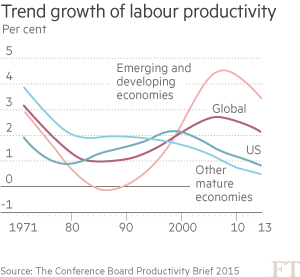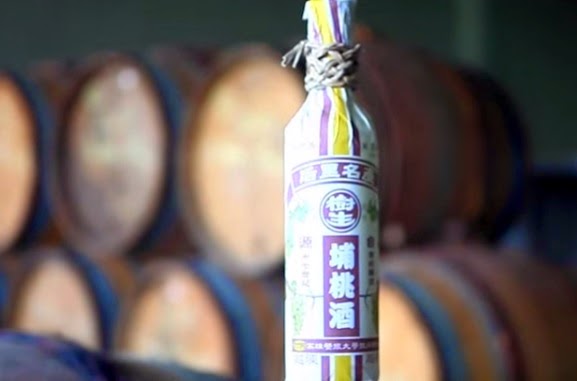Restoring productivity levels is crucial to boosting living standards and filling tax coffers
D
rew Greenblatt surveys the shop floor of his small factory in a down-at-heel district of Baltimore, Maryland, where two workers are using a large steel-bending robot.
“This part used to be made in China,” he says. “But because of the robotics we stole this [manufacturing] from China and now make it in America.”
The introduction of automation at Marlin Steel Wire Products has helped boost employee productivity fourfold since 1998, estimates Mr Greenblatt, whose customers include carmaker
General Motors. The gains in efficiency are impressive but they are not being replicated across America.
Even as
US manufacturers adopt automation as part of their fightback against offshoring to Asia, productivity growth across the economy is at a near standstill. A similar picture is being played out across the globe, exposing the most
pressing problem in the world economy today. Only India and sub-Saharan Africa seem to be immune from slowing productivity growth.
Economists are increasingly alarmed because slower improvements in efficiency will lead to a decline in living standards and less-solid public finances. In the medium term, productivity growth is the most important driver of prosperity. Its weakness in recent years lies at the heart of why advanced nations have remained in a low-growth rut since the financial crisis even as unemployment has fallen.
Janet Yellen, the Federal Reserve chair, raised America’s “relatively weak” productivity in a speech last week and urged new measures to strengthen education, boost entrepreneurship and increase capital investment.
New data from the
Conference Board think-tank show that average labour productivity growth in mature economies slowed to 0.6 per cent in 2014 from 0.8 per cent in 2013, as a result of ebbing performances in the US, Japan and Europe. Productivity, which tracks how efficiently inputs such as labour and capital are used, tends to evolve over long periods. But the Conference Board readings confirm a longer-term trend of sagging growth that is setting off alarm bells around the world.
With ageing populations, mature economies need to boost productivity sharply if they are to escape stagnating livingstandards
“In the past decade the US has had terrible productivity growth and other countries have been slipping relative to the US,” says John Fernald, an economist at the San Francisco Fed.
In the UK, productivity has not improved in eight years, breaking a trend of roughly 2 per cent annual growth stretching back over a century. George Osborne, the chancellor, last week committed the
Conservative government to
boosting productivity.
Faced with rapidly ageing populations and slowing employment growth, mature economies need to boost productivity sharply if they are to escape stagnating living standards. To compensate fully for slower employment growth over the coming 50 years, productivity growth would need to be 80 per cent faster than over the past half-century, according to calculations from McKinsey, the consultancy.
Whether such an acceleration can be achieved depends in part on identifying why growth is slowing. To optimists, the poor numbers are a transitory legacy of the recession. The downturn in global demand has temporarily depressed companies’ willingness to invest in new equipment and ideas, and that more cautious outlook dented productivity.
But the slowdown predated the financial crisis; Conference Board data reveal a longstanding fall in growth across mature economies. In Europe and Japan it started in the 1990s, and is related to slower adoption of technology, it says.
Marco Annunziata, the chief economist at
General Electric, worries there is a structural problem in Europe due to a lack of risk-taking, low R&D spending and inflexible labour markets.
In the US, the most efficient of the major economies, productivity growth began to ebb in 2005. According to Mr Fernald, this was a result of the lapsing of temporary growth dividends from the 1990s IT revolution.
This raises the possibility that the recent, dreary productivity growth in the US is actually a return to an older and weaker trend. Even in emerging economies, where efficiency is catching up, the rate of growth has slowed.
This has major implications in terms of a prolonged shortfall in tax revenues and increased public debt. It was just such a scenario — the fall in productivity growth between 2010 and 2015 — that stretched a planned four-year period of austerity in the UK into a decade of public-sector misery.
Optimists counter that it is just a matter of time before we see an upsurge
in productivity, pointing to innovation in American IT hubs such as Silicon
Valley.
Researchers at Blue River Technology, a California-based agricultural robotics company, envisage farms of the future being surveyed by flocks of drones, and tended by fleets of robots and self-driving tractors. It is already operating teams of “lettuce bots”, which are being dragged across fields in Arizona and California to identify 1.5m individual plants an hour and make decisions on how to fertilise them.
Some argue that the easiest targets for technological progress have already been met. But others say the world is on the cusp of a machine-driven growth spurt, where driverless cars and robots will replace people, and cite companies such as Blue River as evidence.
Another more bullish outlook suggests that the concept of productivity as a measure of living standards is now outdated because quality is difficult to measure in public services such as education, and progress is hard to capture in many consumer technologies. Equivalents to Skype, for instance, were prohibitively expensive a decade ago but now are free, giving people higher standards of living without troubling the statisticians compiling gross domestic product data.
“This takes you into uncharted territory about what progress means in advanced economies,” says Professor Diane Coyle of Manchester university. “There has clearly been an increase in consumer’s welfare, probably extremely large, and we don’t know how it is linked to GDP.”
Mismeasurement might explain how many consumers are better off without appearing to have higher incomes in real terms. But statistical arguments cannot raise incomes or tax revenues, nor do they return sectors with previously high productivity growth back to former levels of success.
Without a return to the former productivity patterns in advanced economies, growth will be permanently lower, as will government revenues. Austerity in the public sector will become a persistent feature and parents will no longer be able to expect their children to earn more than they did. Little is more important in the global economy.
Five drags on productivity
1. Investment is too low
Companies may not be investing enough in new equipment and ideas. Instead they are frittering away cash on share buybacks and dividends that totalled $903bn for S&P 500 companies in 2014. The economist
Andrew Smithers singles out a long-term decline in investment as a share of gross domestic product as a drag on growth, as well as a slowdown in education improvements. The fall in productivity growth started before the financial crisis, suggesting longer term forces are at work.
2. The big innovations have already happened
According to research by John Fernald, the San Francisco Federal Reserve economist, the ‘low-hanging fruit’ from the innovation revolution in IT in the late 1990s and early 2000s was plucked a decade ago and the outlook now is for pedestrian productivity growth. Pessimists argue that since the 1970s we have failed to match the productivity-transforming inventions created earlier in the 20th century.
3. Innovations are not being measured correctly
Much of the technology improvements over the past decade, such as smartphones, have provided huge benefits to consumers without improving the measured output of advanced economies. People with access to free video calls, for example, are better off but are not spending which would benefit the national accounts and productivity statistics. It implies economic progress in the broadest sense is detaching itself from measured gross domestic product.
4. Be patient — it is just a matter of time
The Conference Board data suggest the US is still the most productive of the major economies, especially in hubs such as San Francisco and Boston. One example is in robotics, with Boston Consulting Group predicting 25 per cent of manufacturing tasks will be automated by 2025. However, it is not just about pushing the technological frontier. Three-quarters of the potential productivity growth comes from a broader adoption of existing best practices and companies simply playing catch-up, according to McKinsey.
5. Inefficient services
Many parts of the services sector have fundamental limits on productivity. In the 1960s the economist William Baumol noted that the productivity of a live Beethoven string quartet could not be higher than that of 100 years earlier. This effect results in higher productivity growth in manufacturing rather than other sectors. The move towards advanced services sector economies implies slower overall productivity growth in the medium term but the trends do not explain the recent big falls.













